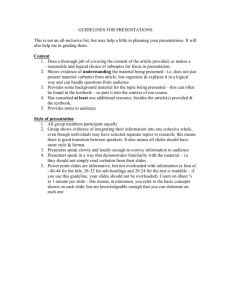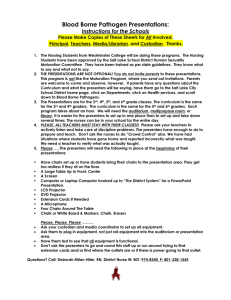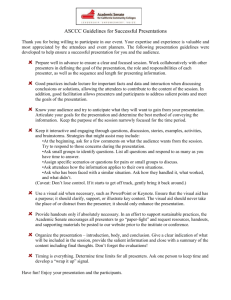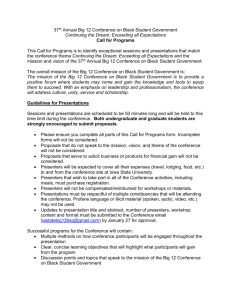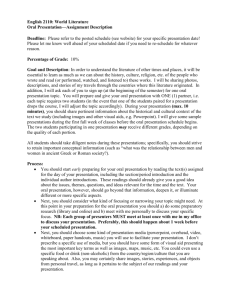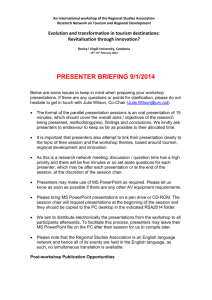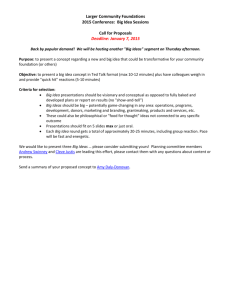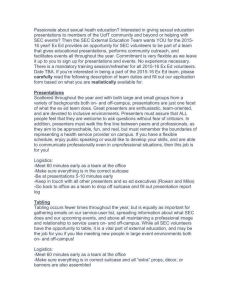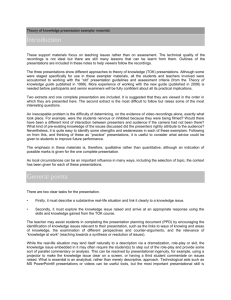Call for Presentation Proposal
advertisement
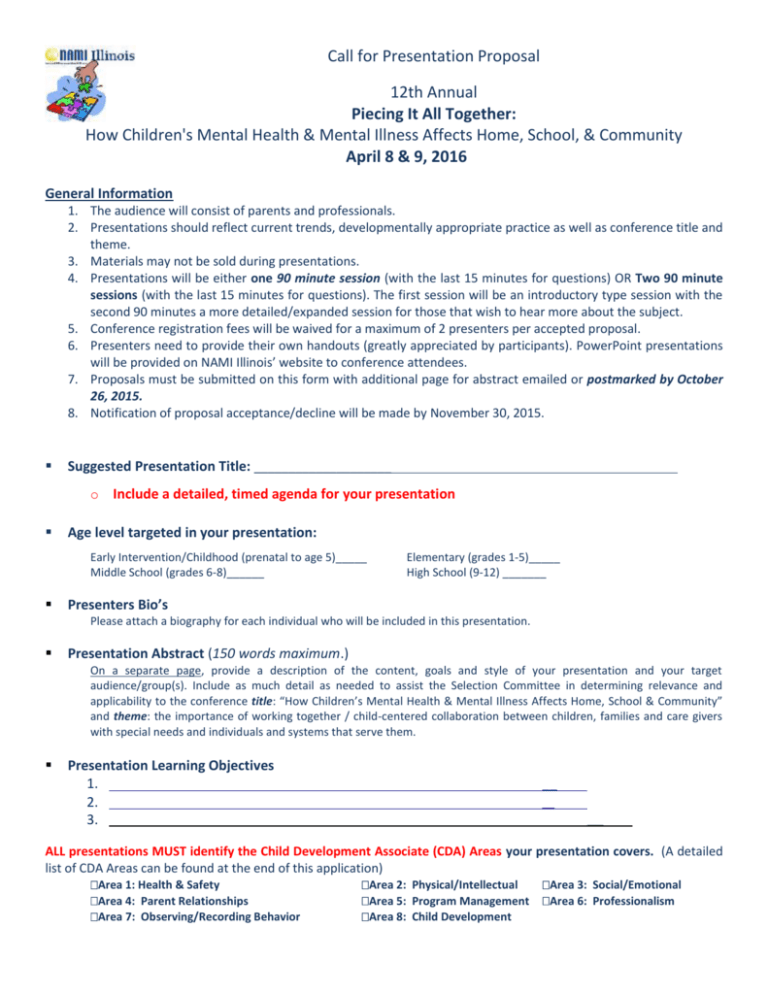
Call for Presentation Proposal 12th Annual Piecing It All Together: How Children's Mental Health & Mental Illness Affects Home, School, & Community April 8 & 9, 2016 General Information 1. The audience will consist of parents and professionals. 2. Presentations should reflect current trends, developmentally appropriate practice as well as conference title and theme. 3. Materials may not be sold during presentations. 4. Presentations will be either one 90 minute session (with the last 15 minutes for questions) OR Two 90 minute sessions (with the last 15 minutes for questions). The first session will be an introductory type session with the second 90 minutes a more detailed/expanded session for those that wish to hear more about the subject. 5. Conference registration fees will be waived for a maximum of 2 presenters per accepted proposal. 6. Presenters need to provide their own handouts (greatly appreciated by participants). PowerPoint presentations will be provided on NAMI Illinois’ website to conference attendees. 7. Proposals must be submitted on this form with additional page for abstract emailed or postmarked by October 26, 2015. 8. Notification of proposal acceptance/decline will be made by November 30, 2015. Suggested Presentation Title: ____________________ o Include a detailed, timed agenda for your presentation Age level targeted in your presentation: Early Intervention/Childhood (prenatal to age 5)_____ Middle School (grades 6-8)______ Elementary (grades 1-5)_____ High School (9-12) _______ Presenters Bio’s Please attach a biography for each individual who will be included in this presentation. Presentation Abstract (150 words maximum.) On a separate page, provide a description of the content, goals and style of your presentation and your target audience/group(s). Include as much detail as needed to assist the Selection Committee in determining relevance and applicability to the conference title: “How Children’s Mental Health & Mental Illness Affects Home, School & Community” and theme: the importance of working together / child-centered collaboration between children, families and care givers with special needs and individuals and systems that serve them. Presentation Learning Objectives 1. 2. 3. __ __ __ ALL presentations MUST identify the Child Development Associate (CDA) Areas your presentation covers. (A detailed list of CDA Areas can be found at the end of this application) Area 1: Health & Safety Area 4: Parent Relationships Area 7: Observing/Recording Behavior Area 2: Physical/Intellectual Area 5: Program Management Area 8: Child Development Area 3: Social/Emotional Area 6: Professionalism "Which of the early intervention principles does this session support? How does this session address the needs of children, birth to three and their families?" "Not applicable, does not address early intervention birth to three population" 1. The primary goal of EI is to support families in promoting their child's optimal development and to facilitate the child's participation in family and community activities. 2. The focus of EI is to encourage the active participation of families in the therapeutic process by imbedding intervention strategies into family routines. It is the parents who provide the real early intervention by creatively adapting their child care methods to facilitate the development of their child, while balancing the needs of the rest of their family. 3. EI requires a collaborative relationship between families and providers, with equal participation by all those involved in the process. An on-going parent-professional dialogue is needed to develop implement, monitor, and modify therapeutic activities. 4. Intervention must be linked to specific goals that are family-centered, functional, and measurable. Intervention strategies should focus on facilitating social interaction, exploration, and autonomy. 5. Intervention should be integrated into a comprehensive plan that encourages transdisciplinary activities and avoids unnecessary duplication of services. The plan should be built around family routines, with written home activity programs to encourage family participation in therapeutic activities on a daily basis. 6. Intervention should be monitored periodically to assure that the strategies implemented are successful in achieving outcomes. 7. Children and their families in the Early Intervention System deserve to have services of the highest quality possible. High standards will be set for the training and credentialing of administrative and intervention staff. Training, supervision, and technology will be focused to achieve excellence. Please fill out completely Name Professional Title __ Affiliation Mailing Address __ City State Phone (area code) Email__ Zip __ _____________ If applicable: Co-presenter’s name Professional Title Affiliation Mailing Address City State Phone (area code) _______ __ __ Zip (Correspondence will be sent ONLY to the primary presenter) Contact information for 2 references regarding prior presentations: 1) Name_______________________________________________ 2) Name_________________________________________ Address______________________________________________ Address_______________________________________ ____________________________________________________ ______________________________________________ Phone_______________________________________________ Phone________________________________________ What Audio-Visual equipment will you need? Please be specific if your needs are not listed below. Lap top computers will not be provided. Handheld Mic Table Top Mic PowerPoint Projector Screen Other Length of presentation: 90 min Your fee: ___________ Two 90 min sessions with first session an introductory and second detailed session to follow Estimated expenses that you would like us to pay: ___________ In-kind contribution? (no fee charged & recognized as a collaborator in the conference flyer/program booklet) YES_____ NO____ Preferred: Friday Saturday / A.M. P.M. No Preference (Preferences will be honored when possible, but cannot be guaranteed.) SUBMISSION CHECKLIST COMPLETED CALL FOR PROPOSAL (CFP) BIOGRAPHIES FOR ALL PRESENTERS ABSTRACT ADDITIONAL INFORMATION TIMED AGENDA: OTHER: Please submit one completed proposal postmarked or emailed by October 26, 2015 to: NAMI Illinois, 218 West Lawrence, Springfield, IL 62074 namiil@sbcglobal.net For more information, please call: NAMI Illinois (217) 522-1403 Include a detailed, timed agenda for your presentation You will be notified by email by November 30, 2015 Resource: Child Development Associate (CDA) Areas Area 1: Health & Safety Training addresses safe environment to prevent and reduce injuries, promote good health and nutrition and provides an environment that contributes to the enjoyable environments that encourage play, exploration and learning. Area 2: Physical/Intellectual Training on a variety of equipment, activities, and opportunities to promote physical development of children, activities and opportunities that encourage curiosity, exploration, and problem solving appropriate to the developmental levels and learning styles of children. Area 3: Social/Emotional Training which teaches providers to actively communicate with children and provides opportunities and support for children to understand, acquire and use verbal and non-verbal means of communicating thoughts and feelings, and stimulate children to play with sound, rhythm, language, materials, space and ideas in individual ways and to express their creative abilities. Area 4: Parent Relationships Training which helps strengthen parent/provider communication, encourage parent involvement in child care programs and supports the child’s relationship with his or her family. Area 5: Program Management Training to ensure effective operations of program, organization, record keeping, teamwork, supervising, etc. Area 6: Professionalism Training which provides skills to promote decisions using early childhood theories and practices, promotes quality in child care services, improving personal and professional growth. Area 7: Observing/Recording Behavior Tools and strategies for objective information collection and discipline techniques. Area 8: Child Development Training on developmental milestones and cultural influences.
